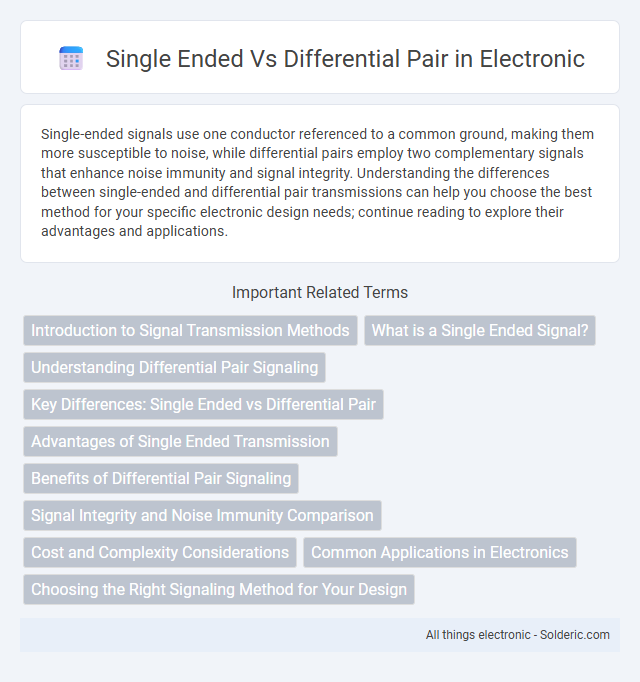Single-ended signals use one conductor referenced to a common ground, making them more susceptible to noise, while differential pairs employ two complementary signals that enhance noise immunity and signal integrity. Understanding the differences between single-ended and differential pair transmissions can help you choose the best method for your specific electronic design needs; continue reading to explore their advantages and applications.
Comparison Table
| Feature | Single Ended | Differential Pair |
|---|---|---|
| Signal Transmission | One signal conductor referenced to ground | Two complementary signal conductors carrying opposite voltages |
| Noise Immunity | Low; susceptible to electromagnetic interference (EMI) | High; common-mode noise cancels out |
| Signal Integrity | Prone to signal degradation over long distances | Maintains integrity over longer distances and higher speeds |
| Complexity | Simple design, fewer conductors | Complex design, requires matched pairs |
| Power Consumption | Generally lower | Typically higher due to dual lines |
| Typical Applications | Audio signals, low-speed data, analog circuits | High-speed digital interfaces, Ethernet, USB, RS-485 |
| Cost | Lower | Higher due to additional wiring and circuitry |
Introduction to Signal Transmission Methods
Single-ended signal transmission uses one conductor referenced to a common ground, making it simpler but more prone to noise and electromagnetic interference. Differential pair transmission employs two conductors carrying equal and opposite signals, enhancing noise immunity and signal integrity over longer distances. High-speed communication standards like USB, HDMI, and Ethernet commonly utilize differential pairs to maintain reliable data transfer in electrically noisy environments.
What is a Single Ended Signal?
A single-ended signal uses one conductor to carry the signal voltage referenced to a common ground, making it simpler but more susceptible to noise and interference. This signal type is common in audio and low-speed digital applications where cost and complexity need to be minimized. Despite its vulnerability to electromagnetic interference, single-ended signaling remains widely used due to its straightforward implementation and compatibility with standard equipment.
Understanding Differential Pair Signaling
Differential pair signaling uses two complementary signals transmitted over paired conductors to enhance noise immunity and signal integrity compared to single-ended signaling, which employs a single signal referenced to ground. This method reduces electromagnetic interference (EMI) and crosstalk by canceling noise through differential voltage measurement between the pair, making it ideal for high-speed data communication and sensitive analog applications. Your choice of differential pair signaling can significantly improve performance in environments with high electrical noise or long cable runs.
Key Differences: Single Ended vs Differential Pair
Single-ended signaling uses one wire per signal with a common ground reference, making it more susceptible to noise and electromagnetic interference. Differential pairs consist of two complementary signals transmitted over paired wires, enhancing noise immunity and signal integrity by canceling out common-mode noise. This results in improved performance for high-speed or long-distance communication compared to single-ended connections.
Advantages of Single Ended Transmission
Single ended transmission simplifies circuit design by using a single signal line referenced to a common ground, reducing the number of required conductors and lowering overall costs. It is highly effective in low-frequency applications where noise interference is minimal, enabling straightforward implementation and maintenance. This method also consumes less power compared to differential pairs, making it ideal for battery-operated or energy-sensitive devices.
Benefits of Differential Pair Signaling
Differential pair signaling offers superior noise immunity by transmitting two complementary signals that cancel out common-mode interference, making it ideal for high-speed data communication and electrically noisy environments. It enhances signal integrity and reduces electromagnetic interference (EMI) compared to single-ended signaling, enabling longer cable lengths and higher data rates without signal degradation. This method also provides better timing accuracy and reduced crosstalk, resulting in more reliable and precise data transmission.
Signal Integrity and Noise Immunity Comparison
Differential pair signaling offers superior noise immunity by transmitting two complementary signals, allowing common-mode noise to be canceled out at the receiver, which significantly enhances signal integrity. Single-ended signals are more susceptible to electromagnetic interference and crosstalk due to their single reference path, leading to higher noise levels and potential signal degradation. High-speed communication systems and sensitive analog circuits typically employ differential pairs to maintain robust signal integrity in noisy environments.
Cost and Complexity Considerations
Single-ended signaling typically incurs lower cost and complexity due to fewer components and simpler PCB routing compared to differential pairs. Differential pairs require tightly controlled impedance and matched trace lengths, increasing design effort and manufacturing expenses. Your choice depends on balancing budget constraints against the need for noise immunity and signal integrity.
Common Applications in Electronics
Single-ended signals are commonly used in simple audio devices, basic sensor interfaces, and microcontroller communication where cost and design simplicity are prioritized. Differential pairs dominate in high-speed data transmission, such as USB, Ethernet, and HDMI, providing noise immunity and signal integrity over long distances. Your choice between single-ended and differential will impact system performance, noise reduction, and overall reliability in electronic applications.
Choosing the Right Signaling Method for Your Design
Choosing between single-ended and differential pair signaling depends on factors such as noise immunity, signal integrity, and board complexity. Differential pairs offer enhanced noise rejection and reduced electromagnetic interference, making them ideal for high-speed and long-distance communication. Single-ended signaling is simpler and cost-effective for shorter runs and low-speed applications where noise is less critical.
Single ended vs Differential pair Infographic

 solderic.com
solderic.com